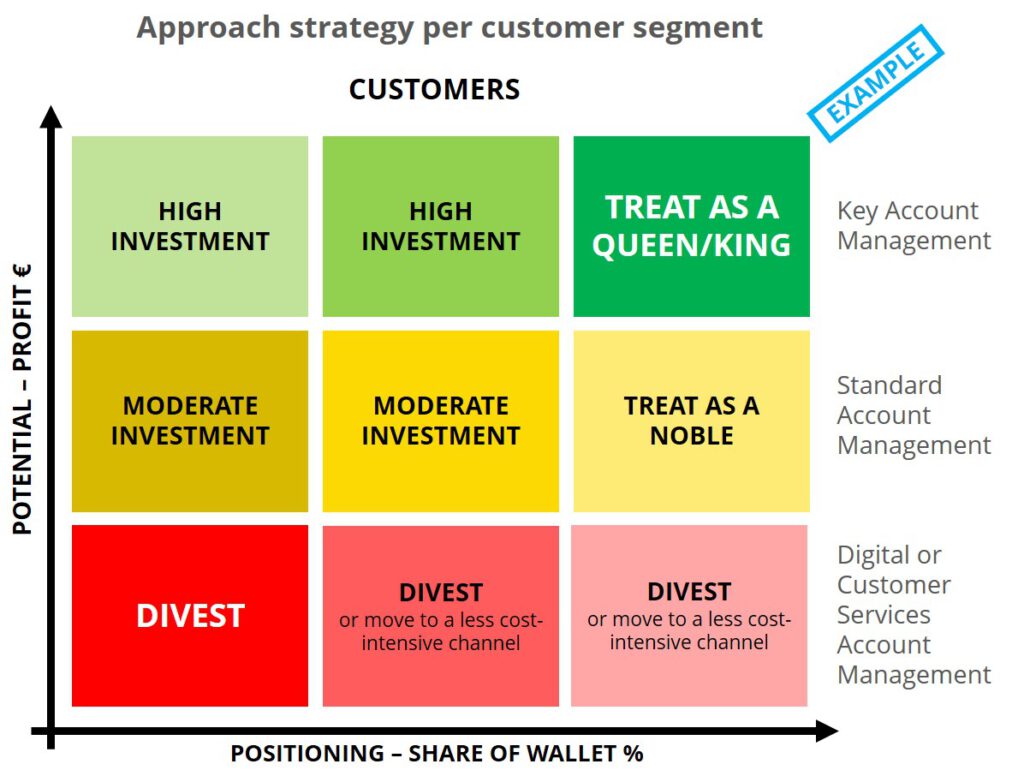It is five to twelve. You have to hurry. Time is money! Three important customers are waiting for you to respond as soon as possible. You need to put pressure on all the sales supporting departments to get the quotes ready on time, but with any luck, you will get one.
Who decides on which customers sales teams and back-office employees should focus?
It is not so easy to answer this question. If there is no clear guidance to the organization, the natural prioritization process will be “first come, first serve”. Not to mention any adjustments based on the level of relationship the sales supporting employees have with the sales rep, and personal feelings about the customer’s importance.
In this article, you will find the answer to this question and tips on how to improve your capacity to focus on the most promising customers.
Let´s now analyze together how to avoid the 3 common traps in customer segmentation:
- Unsharp view of the most promising and reliable customers
- Vague rules on how sales teams should invest their time and budget
- Territories with different potential but the same cost to serve
- Unsharp view of the most promising and reliable customers
If you assign a wrong priority to valuable customers, you then open the door for your competitors to take them away from you. The crucial point is to find out who your most valuable customers really are.
Customer value is equal to how much Potential Profit this customer can generate for you. Yes, profit! Turnover is not a good measure when customers have different costs to serve and are granted different discount levels. Notice the word “potential”. Past and present numbers aren’t always a good indicator for the future, particularly so in dynamic markets, in which customer behavior is subject to constant change and customer consolidation is on an increasing trend.
The second measure that should be taken into account is how much of this potential your customer is willing to pass on to you. This is also known as Share of Wallet (SoW). Usually, the greater the SoW, the lower the cost to serve in percentage of the turnover. It especially happens when the SoW was gradually achieved, based on mutual trust, positive customer experience, and the customer learning process with respect to your company and products.
Therefore, when you need to evaluate how to allocate your company resources and prioritize customer requests, I strongly suggest you base your decisions on Profit Potential and Share of Wallet (SoW).
Let´s concentrate on how to use this segmentation methodology to guide your employees, so that they will be able to focus on your most promising customer.

- Vague rules on how sales teams should invest their time and budget
Divide your customers into 3 categories: high, medium, and low potential. This will give you a better overview of customer value.
Customers in high potential segments will usually be served by key account management, those with medium potential by standard account management, and low potential customers by inside sales, customer services, and digital channels. Most commonly, low potential customers are strong candidates for divestment, thereby freeing your resources to better serve medium and high potential ones. Another possibility is, as just mentioned, to move them to less cost-intensive channels.
Following this methodology, you have made the first important step to allocate time of your sales teams and budget to focus on the most promising customers.
The Share of Wallet factor (SoW) is another important measure to guide sales teams on how to invest their time. The process of customer acquisition is very time-consuming, therefore customers with a low Share of Wallet will require more time and budget for your teams.
Do not fall into the trap of giving a higher priority to customers you are acquiring, in detriment of those giving a significant SoW! Losing a good customer has a tremendous impact on your profitability. Instead, compensate your valuable and long-term customers with better pricing conditions and premium services.
For pricing tips, please see the KRAEMER article: Price leakage, the hole that only increases!
Finally, we can’t forget the issue of dealing with daily customer requests. Your CRM system should be configured so that requests are prioritized according to customer potential. In case a priority should change, for example following a strategic decision, the CRM should trigger an internal approval process. Everything will be documented in CRM and available to be analyzed. This will help to fine-tune the prioritization process and ascertain that the approved exceptions are bringing expected results.

- Territories with different potential but the same cost to serve
A good result of customer segmentation is territory optimization. It is common to find that some territories just have low potential customers, while others show a concentration of high and medium ones. Therefore, resource allocation follows the potential to better serve your high potential customers and balance the cost to serve.
As you have seen on the image above, after the territory optimization, the territories disappeared. It is just one possibility, but what is important, is that low potential customers will be served only by digital channels and customer services, while the high potential ones will have much more support from the key account managers. Most of it can be done merely reallocating your current employees.
It is easy to talk about territory optimization, however, it is one of the biggest worries of sales reps and managers. This concern is valid, but there are solutions available. It is key that this process carefully considers how to not demotivate or better even strongly motivate your valuable employees.
The current digitalization wave we are experiencing makes territory optimization significantly easier. Many customers are increasingly accepting a bigger number of remote interactions with sales representatives. This allows for sales employees to stay in the geographical region they prefer, while enabling the companies to assign accounts to them independent of the geographic distance.
It is very important to keep in mind that territory optimization can drastically reduce your cost to serve while improving services to your most promising customers and consequently leverage your turnover and profit.
After applying the customer segmentation methodology suggested here, your sales employees and sales support teams will no longer waste their valuable time selecting which customers to focus on and how they should allocate their time to maximize your profitability. Customer segmentation and its continuous fine-tuning process will do it for them. Do not underestimate how powerful and beneficial this is for your company’s long-term profits!

Caio Kraemer is a professional with more than 10 years of practical experience implementing and managing Sales Excellence projects in Germany and globally. His 25 years of experience extend to several industries, market structures, consumable and durable goods. The success of his projects is based on passion, pragmatism, know-how, perseverance and change management.



© KRAEMER Sales Excellence Consulting GmbH